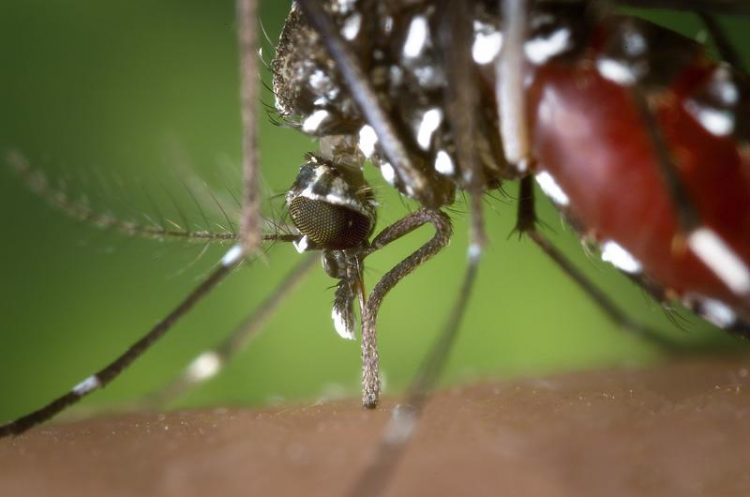Developing Chikungunya Virus Vaccines – Learning from the Immune Response towards the Infection

The Chikungunya virus (CHIKV) is transmitted by aedes mosquitos such as the Asian tiger mosquito (Aedes albopictus) and causes Chikungunya fever in humans. (Source: https://www.pei.de/EN/newsroom/press-releases/year/2019/25-developing-chikungunya-virus-vaccines.html)
The Chikungunya virus (CHIKV) is transmitted by aedes mosquitos such as the Asian tiger mosquito (Aedes albopictus) and causes Chikungunya fever in humans.
Scientists led by Prof. Barbara Schnierle, head of the “AIDS, New and Novel Pathogens” department, and Dr. Sally Baylis, researcher in the Virus Safety department of the Paul-Ehrlich-Institut, in collaboration with researchers from Themis Bioscience GmBH, Austria, and the Instituto Oswaldo Cruz, Rio de Janeiro, Brazil, have investigated the generation of CHIKV-specific antibodies in individuals who had suffered from a CHIKV infection and recovered.
This humoral immune response, i.e. the type and extent of antibody formation against the pathogen was compared with the formation of antibodies from healthy participants who had been vaccinated with a Chikungunya vaccine candidate. The vaccine candidate investigated in this study was a measles vector vaccine (MV-CHIK).
In the study, her team compared the type and extent of antibody formation with the formation of antibodies (humoral response) in healthy participants who had been vaccinated with a Chikungunya vaccine candidate (measles vector vaccine MV-CHIK). In those individuals who had undergone a CHIKV infection, CHIKV-specific antibody levels were two to six times higher than in vaccinated individual.
As the main antigen structures against which the antibodies were formed, the research group identified a binding domain of the envelope protein E2 as well as so-called acid sensitive regions (ASPs) of the virus for both groups. Some of the antibodies raised against these regions, known as neutralising antibodies, were able to prevent the CHIKV from entering the host cell.
“The findings are helpful for the design of effective vaccines, the evaluation of the efficacy, and the identification of specific neutralising antibodies to prevent the Chikungunya virus from entering into the target cells,” as Professor Schnierle explained the significance of these results.
Background
The CHIKV is predominant in tropical and subtropical regions and has already caused epidemics in Africa, parts of the Indian Ocean regions, South-East Asia, the Caribbean, as well as Central and South America. Chinkungunya infections are reported regularly from people returning home from travels. The infection is notifiable in Germany.
Since the Asian tiger mosquito is increasingly spreading and meanwhile also occurs in Germany, further spreading of the virus must be expected. Symptoms of a Chikungunya infection include fever and strong limb pain – a symptom from which the disease derives its name – Chikungunya means “the one who walks bent”. In 30 to 40 percent of the cases, this limb pain can last several months or even years. A vaccine is so far not available.
CHIKV is a single-strain RNA virus. Its envelope proteins E1 and E2 form docking sites on the surface of the virus, thus facilitating the infection in the host cell. CHIKV-specific antibodies are of major significance for the protection from the disease. Thus, mice were protected from a CHIKV infection after injection of CHIKV-specific monoclonal antibodies.
Henss L, Yue C, von Rhein C, Tschismarov R, Lewis-Ximenez LL, Dölle A, Baylis SA, Schnierle BS (2019)
Analysis of humoral immune responses in chikungunya virus (CHIKV) infected patients and individuals vaccinated with a candidate CHIKV vaccine.
J Infect Dec 12 [Epub ahead of print].
DOI:10.1093/infdis/jiz658
https://doi.org/10.1093/infdis/jiz658 – Abstract of the publication
https://www.pei.de/EN/newsroom/press-releases/year/2019/25-developing-chikunguny… – this press release on the PEI website
Media Contact
All latest news from the category: Life Sciences and Chemistry
Articles and reports from the Life Sciences and chemistry area deal with applied and basic research into modern biology, chemistry and human medicine.
Valuable information can be found on a range of life sciences fields including bacteriology, biochemistry, bionics, bioinformatics, biophysics, biotechnology, genetics, geobotany, human biology, marine biology, microbiology, molecular biology, cellular biology, zoology, bioinorganic chemistry, microchemistry and environmental chemistry.
Newest articles

Making diamonds at ambient pressure
Scientists develop novel liquid metal alloy system to synthesize diamond under moderate conditions. Did you know that 99% of synthetic diamonds are currently produced using high-pressure and high-temperature (HPHT) methods?[2]…

Eruption of mega-magnetic star lights up nearby galaxy
Thanks to ESA satellites, an international team including UNIGE researchers has detected a giant eruption coming from a magnetar, an extremely magnetic neutron star. While ESA’s satellite INTEGRAL was observing…

Solving the riddle of the sphingolipids in coronary artery disease
Weill Cornell Medicine investigators have uncovered a way to unleash in blood vessels the protective effects of a type of fat-related molecule known as a sphingolipid, suggesting a promising new…





















